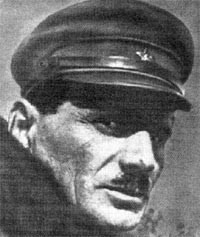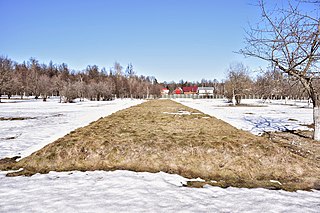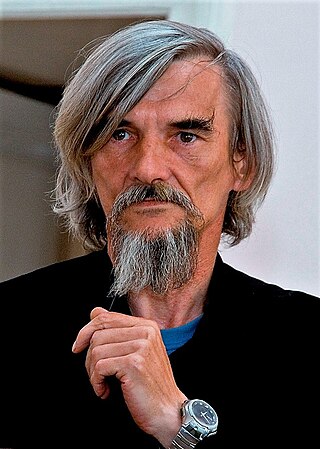
The Great Purge or the Great Terror, also known as the Year of '37 and the Yezhovshchina, was Soviet General Secretary Joseph Stalin's campaign to solidify his power over the Communist Party of the Soviet Union and the state; the purges were also designed to remove the remaining influence of Leon Trotsky as well as other prominent political rivals within the party. It occurred from August 1936 to March 1938.

The Republic of Karelia, also known as just Karelia, is a republic of Russia situated in Northwest Russia. The republic is a part of the Northwestern Federal District, and covers an area of 172,400 square kilometres, with a population of 533,121 residents. Its capital is Petrozavodsk.

The Solovki special camp, was set up in 1923 on the Solovetsky Islands in the White Sea as a remote and inaccessible place of detention, primarily intended for socialist opponents of Soviet Russia's new Bolshevik regime. The first book on the Gulag, namely, In the Claws of the GPU (1934) by Francišak Aljachnovič, described the Solovki prison camp.
Memorial is an international human rights organisation, founded in Russia during the fall of the Soviet Union to study and examine the human rights violations and other crimes committed under Joseph Stalin's reign. Subsequently, it expanded the scope of its research to cover the entire Soviet period.

Naftaly Aronovich Frenkel was a Soviet security officer and member of the Soviet secret police. Frenkel is best known for his role in the organisation of work in the Gulag, starting from the forced labor camp of the Solovetsky Islands, which is recognised as one of the earliest sites of the Gulag.

The History of Karelia is about the cultural and geopolitical region of Karelia, in present-day eastern Finland and northwestern Russia in northern Europe. The Karelian people's presence can be dated back to the 7th millennium BC–6th millennium BC.
In July 2010, a mass grave was discovered next to the Peter and Paul Fortress in St. Petersburg, containing the corpses of 80 military officers executed during the Red Terror of 1918–1921. By 2013 a total of 156 bodies had been found in the same location. At about the same time a mass grave from the Stalin period was discovered at the other end of the country in Vladivostok.

The Remembrance Day for the Victims of Political Repression is an annual day when victims of political repression in the Soviet Union are remembered and mourned across the Russian Federation.

Hryhorii Danylovych Epik was a Ukrainian writer and journalist. He supported the Soviet Ukrainization during the 1920s, which likely led to his arrest and execution during the Great Purge in the 1930s.

The Butovo Firing Range or Butovo Shooting Range was an execution site of the Soviet secret police located near Drozhzhino in Leninsky District, Moscow Oblast from 1938 to 1953. Its use for mass execution has been documented; it was prepared as a site for mass burial. As the late Arseny Roginsky explained: "firing range" was a popular euphemism adopted to describe the mysterious and closely-guarded plots of land that the NKVD began to set aside for mass burials on the eve of the Great Terror.

Sandarmokh is a forest massif 12 km (7.5 mi) from Medvezhyegorsk in the Republic of Karelia where possibly thousands of victims of Stalin's Great Terror were executed. More than 58 nationalities were shot and buried there by the NKVD in 236 communal pits over a 14-month period in 1937 and 1938.

Arseny Borisovich Roginsky was a Soviet dissident and Russian historian. He was one of the founders of the International Historical and Civil Rights Society Memorial, and its head since 1998.

The Kommunarka firing range, former dacha of secret police chief Genrikh Yagoda, was used as a burial ground from 1937 to 1941. Executions may have been carried out there by the NKVD during the Great Terror and until the war started; alternatively, bodies of those shot elsewhere might have been brought there for later interment. As Russian historian Arseny Roginsky explained: "firing range" was a popular euphemism adopted to describe mysterious and closely-guarded plots of land that the NKVD began to set aside for mass burials on the eve of the Great Terror.
Mikhail Rodionovich Matveyev was a senior NKVD executioner, sent to begin the mass shootings at Sandarmokh in Karelia in the late 1930s.

Yury Alexeyevich Dmitriev Юрий Алексеевич Дмитриев is a local historian and activist in Karelia. Since the early 1990s, he has worked to locate the execution sites of Stalin's Great Terror in Karelia and, through work in the archives, to identify as many as possible of the buried victims they contain. He has worked continually since the late 1980s to compile "Books of Remembrance" for Karelia, listing all the names of those executed there.

The 2017 Republic of Karelia head election took place on 10 September 2017, on common election day. Acting Head Artur Parfenchikov was elected for his first full term. It was the first direct Karelia head election in 15 years since Sergey Katanandov won his second term in April 2002.

Shio Batmanishvili was a Georgian Greek Catholic, both a hieromonk and the superior of the Servites of the Immaculate Conception, a survivor of the Gulag at Solovki prison camp, and a martyr during Joseph Stalin's Great Purge.
The Finnish Operation of the NKVD was a mass arrest, execution and deportations of persons of Finnish origin in the Soviet Union by the NKVD during the period of Great Purge (1937–1938). It was a part of the larger mass operations of the NKVD which targeted many minority nationalities in the Soviet Union. Different estimations range from 8,000 to 25,000 of Finns killed or disappearing during the repression.















